HRM 345: Strategies for Building Effective Teams in HRM
VerifiedAdded on 2023/03/23
|6
|1452
|64
Report
AI Summary
This report examines key strategies for building effective teams, particularly in a multinational context, within the framework of HRM 345. The analysis begins by identifying critical factors for team composition, emphasizing trust, leveraging differences, and adaptability. It then addresses cultural competence and diversity, proposing methods to foster respect, establish norms, and promote accountability. Furthermore, the report explores the essential elements for virtual team success, including effective communication, trust-building, and the use of appropriate technology. The assessment of team performance focuses on meeting deadlines, quality of work, and clear objectives. Finally, the report identifies essential leadership skills for virtual teams, such as communication, accountability management, conflict resolution, and change management. The report draws on academic sources to support its arguments and provide practical insights into team building and leadership within HRM.
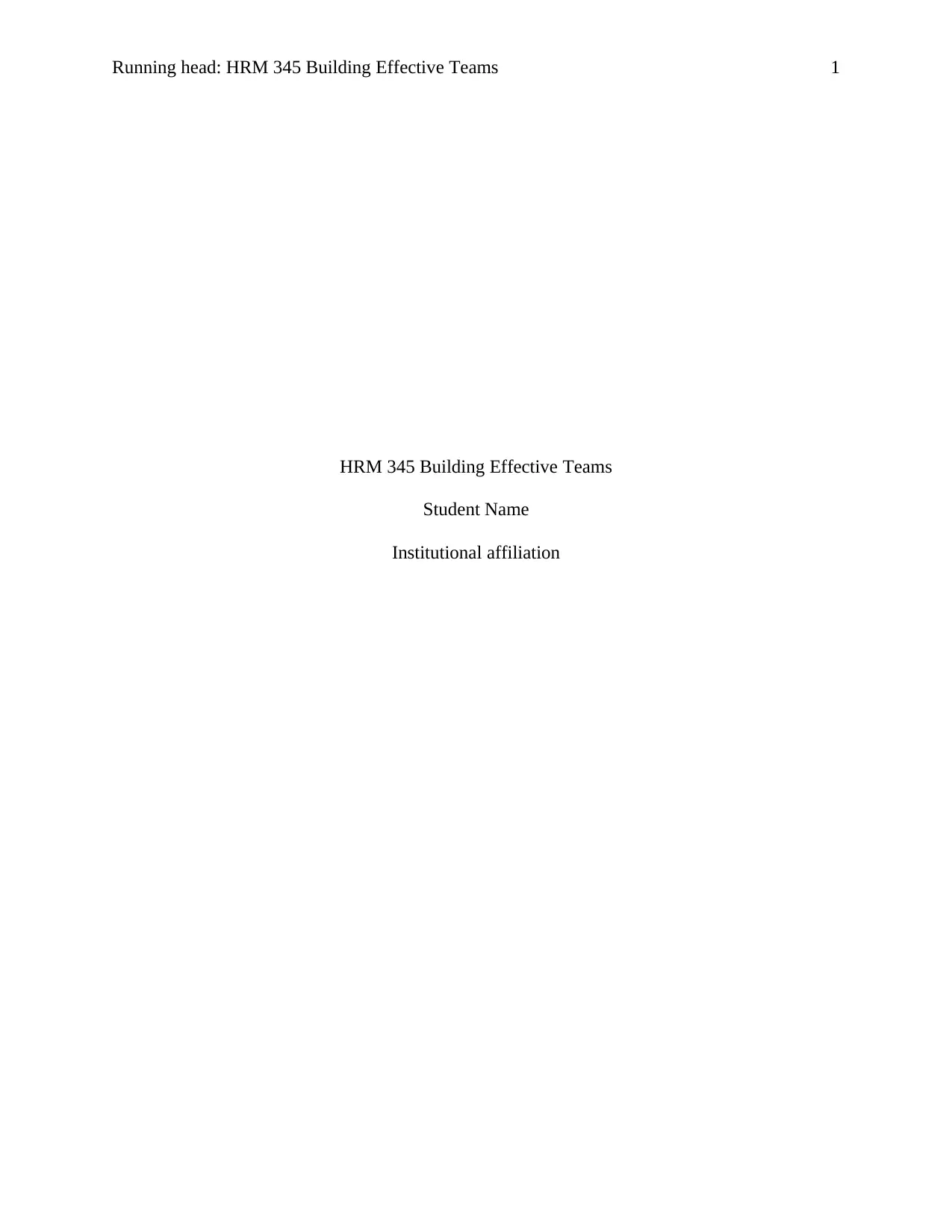
Running head: HRM 345 Building Effective Teams 1
HRM 345 Building Effective Teams
Student Name
Institutional affiliation
HRM 345 Building Effective Teams
Student Name
Institutional affiliation
Paraphrase This Document
Need a fresh take? Get an instant paraphrase of this document with our AI Paraphraser
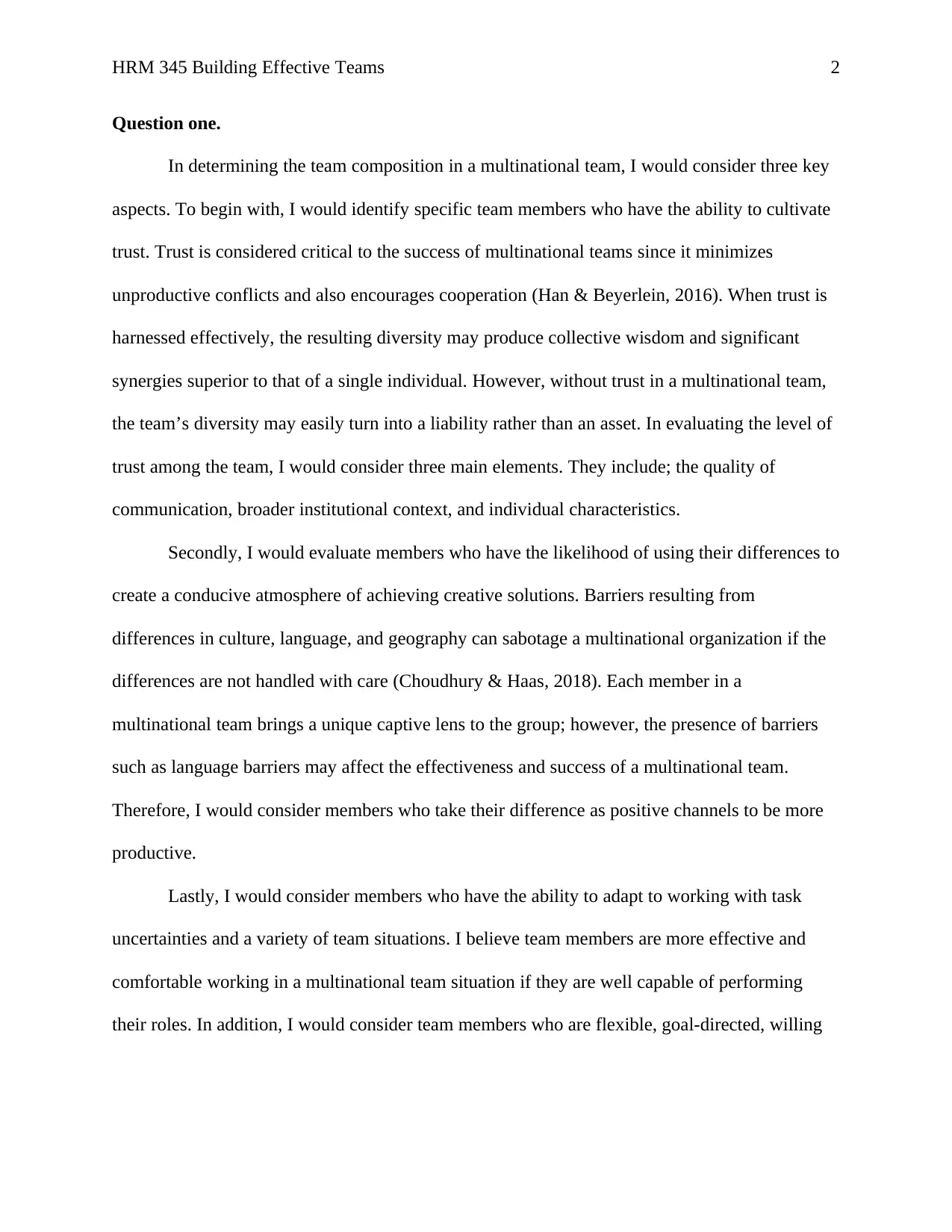
HRM 345 Building Effective Teams 2
Question one.
In determining the team composition in a multinational team, I would consider three key
aspects. To begin with, I would identify specific team members who have the ability to cultivate
trust. Trust is considered critical to the success of multinational teams since it minimizes
unproductive conflicts and also encourages cooperation (Han & Beyerlein, 2016). When trust is
harnessed effectively, the resulting diversity may produce collective wisdom and significant
synergies superior to that of a single individual. However, without trust in a multinational team,
the team’s diversity may easily turn into a liability rather than an asset. In evaluating the level of
trust among the team, I would consider three main elements. They include; the quality of
communication, broader institutional context, and individual characteristics.
Secondly, I would evaluate members who have the likelihood of using their differences to
create a conducive atmosphere of achieving creative solutions. Barriers resulting from
differences in culture, language, and geography can sabotage a multinational organization if the
differences are not handled with care (Choudhury & Haas, 2018). Each member in a
multinational team brings a unique captive lens to the group; however, the presence of barriers
such as language barriers may affect the effectiveness and success of a multinational team.
Therefore, I would consider members who take their difference as positive channels to be more
productive.
Lastly, I would consider members who have the ability to adapt to working with task
uncertainties and a variety of team situations. I believe team members are more effective and
comfortable working in a multinational team situation if they are well capable of performing
their roles. In addition, I would consider team members who are flexible, goal-directed, willing
Question one.
In determining the team composition in a multinational team, I would consider three key
aspects. To begin with, I would identify specific team members who have the ability to cultivate
trust. Trust is considered critical to the success of multinational teams since it minimizes
unproductive conflicts and also encourages cooperation (Han & Beyerlein, 2016). When trust is
harnessed effectively, the resulting diversity may produce collective wisdom and significant
synergies superior to that of a single individual. However, without trust in a multinational team,
the team’s diversity may easily turn into a liability rather than an asset. In evaluating the level of
trust among the team, I would consider three main elements. They include; the quality of
communication, broader institutional context, and individual characteristics.
Secondly, I would evaluate members who have the likelihood of using their differences to
create a conducive atmosphere of achieving creative solutions. Barriers resulting from
differences in culture, language, and geography can sabotage a multinational organization if the
differences are not handled with care (Choudhury & Haas, 2018). Each member in a
multinational team brings a unique captive lens to the group; however, the presence of barriers
such as language barriers may affect the effectiveness and success of a multinational team.
Therefore, I would consider members who take their difference as positive channels to be more
productive.
Lastly, I would consider members who have the ability to adapt to working with task
uncertainties and a variety of team situations. I believe team members are more effective and
comfortable working in a multinational team situation if they are well capable of performing
their roles. In addition, I would consider team members who are flexible, goal-directed, willing
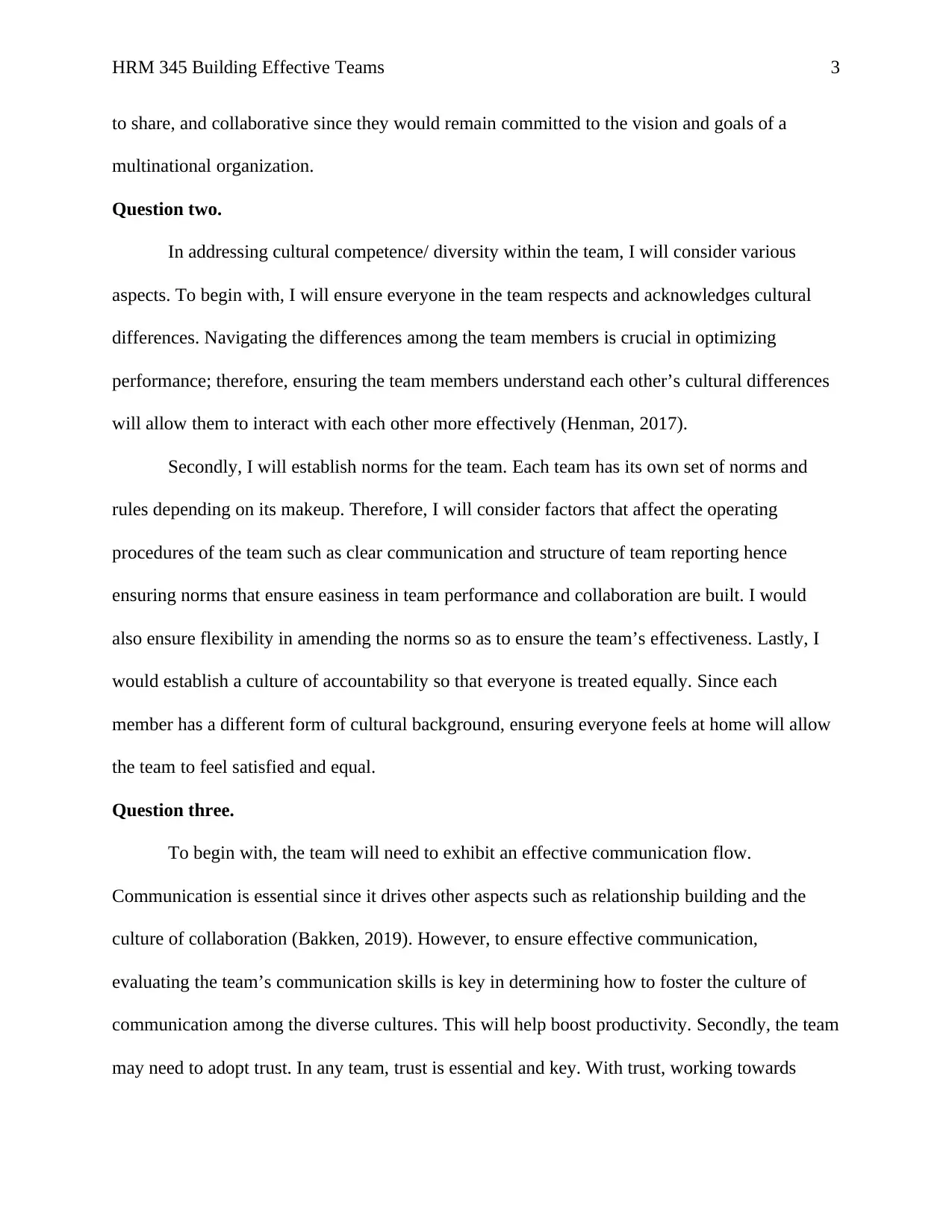
HRM 345 Building Effective Teams 3
to share, and collaborative since they would remain committed to the vision and goals of a
multinational organization.
Question two.
In addressing cultural competence/ diversity within the team, I will consider various
aspects. To begin with, I will ensure everyone in the team respects and acknowledges cultural
differences. Navigating the differences among the team members is crucial in optimizing
performance; therefore, ensuring the team members understand each other’s cultural differences
will allow them to interact with each other more effectively (Henman, 2017).
Secondly, I will establish norms for the team. Each team has its own set of norms and
rules depending on its makeup. Therefore, I will consider factors that affect the operating
procedures of the team such as clear communication and structure of team reporting hence
ensuring norms that ensure easiness in team performance and collaboration are built. I would
also ensure flexibility in amending the norms so as to ensure the team’s effectiveness. Lastly, I
would establish a culture of accountability so that everyone is treated equally. Since each
member has a different form of cultural background, ensuring everyone feels at home will allow
the team to feel satisfied and equal.
Question three.
To begin with, the team will need to exhibit an effective communication flow.
Communication is essential since it drives other aspects such as relationship building and the
culture of collaboration (Bakken, 2019). However, to ensure effective communication,
evaluating the team’s communication skills is key in determining how to foster the culture of
communication among the diverse cultures. This will help boost productivity. Secondly, the team
may need to adopt trust. In any team, trust is essential and key. With trust, working towards
to share, and collaborative since they would remain committed to the vision and goals of a
multinational organization.
Question two.
In addressing cultural competence/ diversity within the team, I will consider various
aspects. To begin with, I will ensure everyone in the team respects and acknowledges cultural
differences. Navigating the differences among the team members is crucial in optimizing
performance; therefore, ensuring the team members understand each other’s cultural differences
will allow them to interact with each other more effectively (Henman, 2017).
Secondly, I will establish norms for the team. Each team has its own set of norms and
rules depending on its makeup. Therefore, I will consider factors that affect the operating
procedures of the team such as clear communication and structure of team reporting hence
ensuring norms that ensure easiness in team performance and collaboration are built. I would
also ensure flexibility in amending the norms so as to ensure the team’s effectiveness. Lastly, I
would establish a culture of accountability so that everyone is treated equally. Since each
member has a different form of cultural background, ensuring everyone feels at home will allow
the team to feel satisfied and equal.
Question three.
To begin with, the team will need to exhibit an effective communication flow.
Communication is essential since it drives other aspects such as relationship building and the
culture of collaboration (Bakken, 2019). However, to ensure effective communication,
evaluating the team’s communication skills is key in determining how to foster the culture of
communication among the diverse cultures. This will help boost productivity. Secondly, the team
may need to adopt trust. In any team, trust is essential and key. With trust, working towards
⊘ This is a preview!⊘
Do you want full access?
Subscribe today to unlock all pages.

Trusted by 1+ million students worldwide
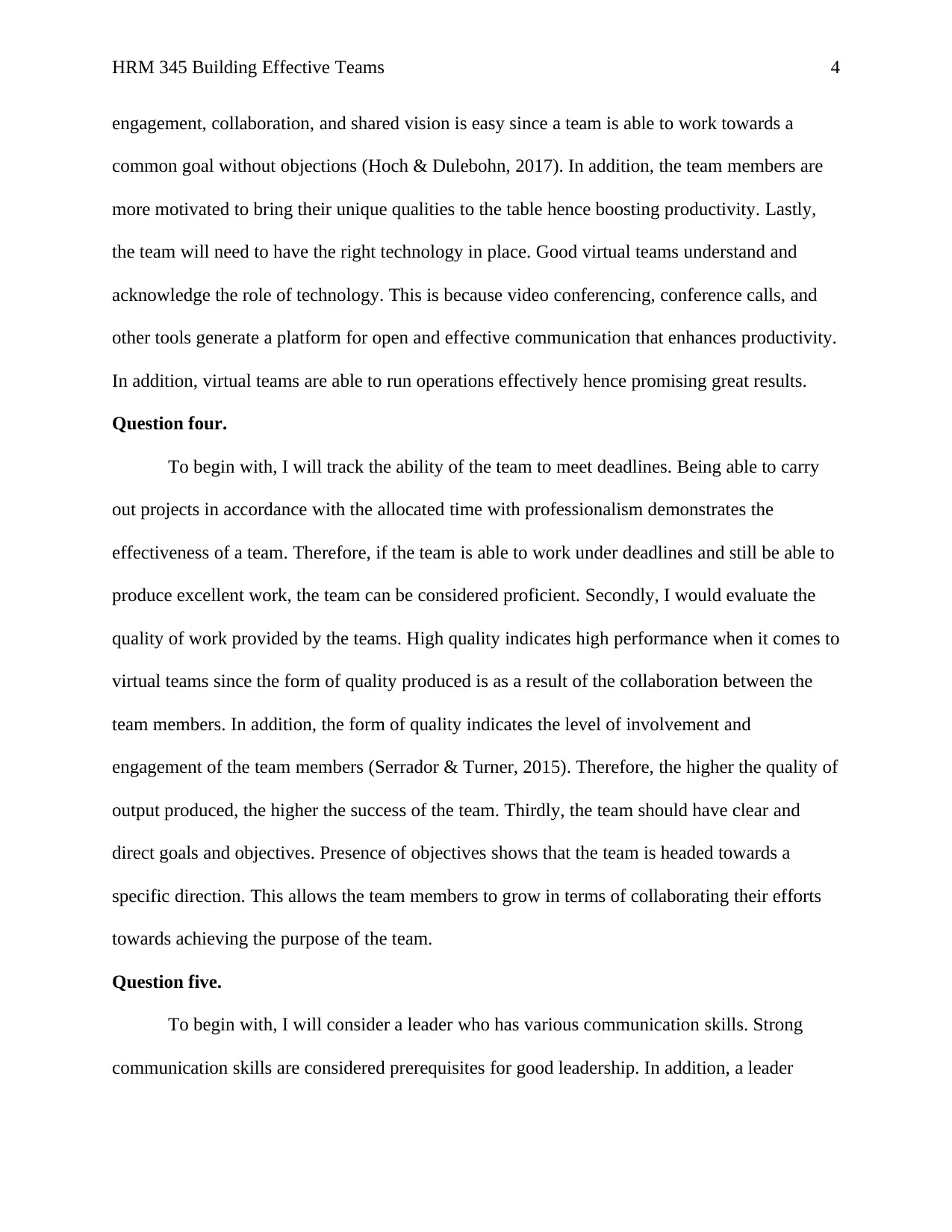
HRM 345 Building Effective Teams 4
engagement, collaboration, and shared vision is easy since a team is able to work towards a
common goal without objections (Hoch & Dulebohn, 2017). In addition, the team members are
more motivated to bring their unique qualities to the table hence boosting productivity. Lastly,
the team will need to have the right technology in place. Good virtual teams understand and
acknowledge the role of technology. This is because video conferencing, conference calls, and
other tools generate a platform for open and effective communication that enhances productivity.
In addition, virtual teams are able to run operations effectively hence promising great results.
Question four.
To begin with, I will track the ability of the team to meet deadlines. Being able to carry
out projects in accordance with the allocated time with professionalism demonstrates the
effectiveness of a team. Therefore, if the team is able to work under deadlines and still be able to
produce excellent work, the team can be considered proficient. Secondly, I would evaluate the
quality of work provided by the teams. High quality indicates high performance when it comes to
virtual teams since the form of quality produced is as a result of the collaboration between the
team members. In addition, the form of quality indicates the level of involvement and
engagement of the team members (Serrador & Turner, 2015). Therefore, the higher the quality of
output produced, the higher the success of the team. Thirdly, the team should have clear and
direct goals and objectives. Presence of objectives shows that the team is headed towards a
specific direction. This allows the team members to grow in terms of collaborating their efforts
towards achieving the purpose of the team.
Question five.
To begin with, I will consider a leader who has various communication skills. Strong
communication skills are considered prerequisites for good leadership. In addition, a leader
engagement, collaboration, and shared vision is easy since a team is able to work towards a
common goal without objections (Hoch & Dulebohn, 2017). In addition, the team members are
more motivated to bring their unique qualities to the table hence boosting productivity. Lastly,
the team will need to have the right technology in place. Good virtual teams understand and
acknowledge the role of technology. This is because video conferencing, conference calls, and
other tools generate a platform for open and effective communication that enhances productivity.
In addition, virtual teams are able to run operations effectively hence promising great results.
Question four.
To begin with, I will track the ability of the team to meet deadlines. Being able to carry
out projects in accordance with the allocated time with professionalism demonstrates the
effectiveness of a team. Therefore, if the team is able to work under deadlines and still be able to
produce excellent work, the team can be considered proficient. Secondly, I would evaluate the
quality of work provided by the teams. High quality indicates high performance when it comes to
virtual teams since the form of quality produced is as a result of the collaboration between the
team members. In addition, the form of quality indicates the level of involvement and
engagement of the team members (Serrador & Turner, 2015). Therefore, the higher the quality of
output produced, the higher the success of the team. Thirdly, the team should have clear and
direct goals and objectives. Presence of objectives shows that the team is headed towards a
specific direction. This allows the team members to grow in terms of collaborating their efforts
towards achieving the purpose of the team.
Question five.
To begin with, I will consider a leader who has various communication skills. Strong
communication skills are considered prerequisites for good leadership. In addition, a leader
Paraphrase This Document
Need a fresh take? Get an instant paraphrase of this document with our AI Paraphraser
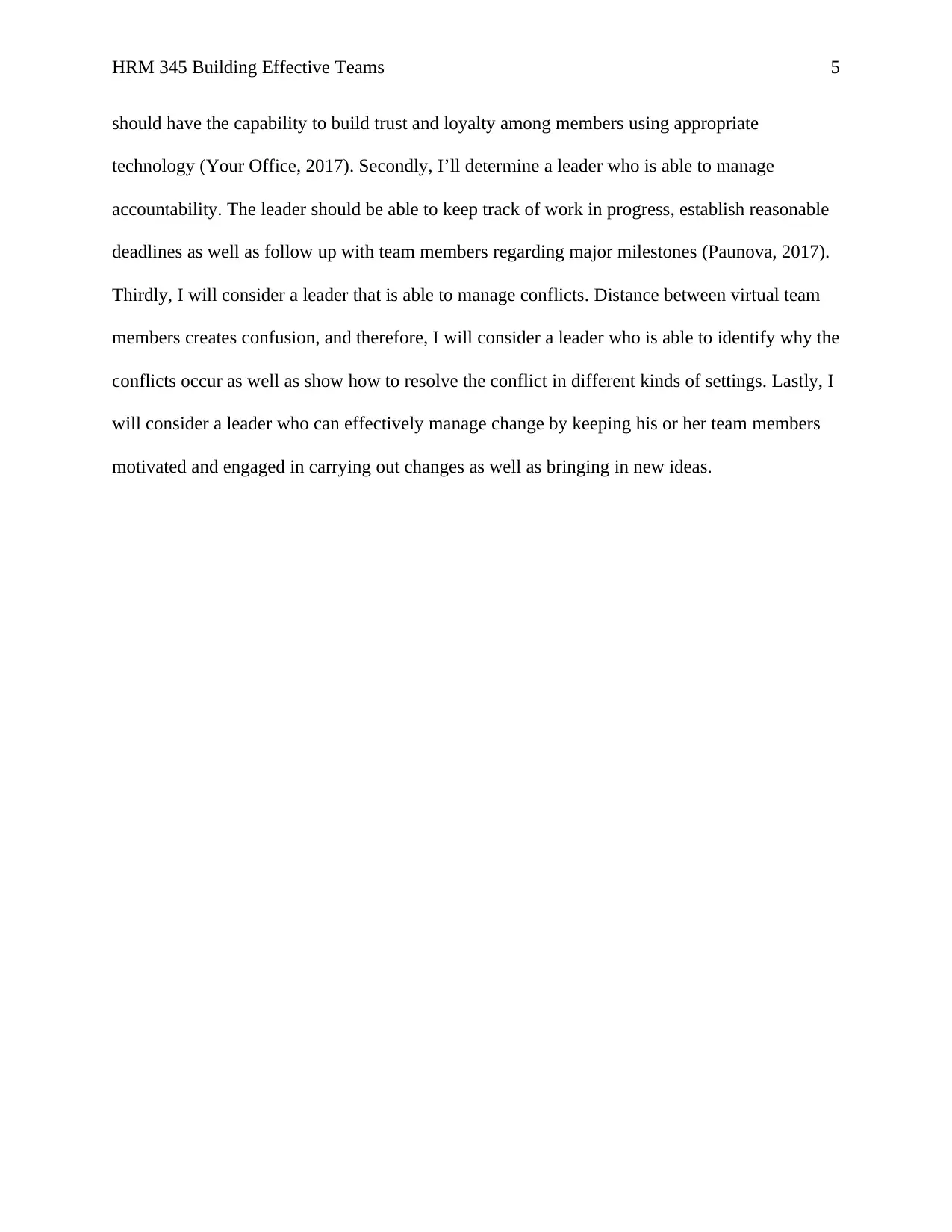
HRM 345 Building Effective Teams 5
should have the capability to build trust and loyalty among members using appropriate
technology (Your Office, 2017). Secondly, I’ll determine a leader who is able to manage
accountability. The leader should be able to keep track of work in progress, establish reasonable
deadlines as well as follow up with team members regarding major milestones (Paunova, 2017).
Thirdly, I will consider a leader that is able to manage conflicts. Distance between virtual team
members creates confusion, and therefore, I will consider a leader who is able to identify why the
conflicts occur as well as show how to resolve the conflict in different kinds of settings. Lastly, I
will consider a leader who can effectively manage change by keeping his or her team members
motivated and engaged in carrying out changes as well as bringing in new ideas.
should have the capability to build trust and loyalty among members using appropriate
technology (Your Office, 2017). Secondly, I’ll determine a leader who is able to manage
accountability. The leader should be able to keep track of work in progress, establish reasonable
deadlines as well as follow up with team members regarding major milestones (Paunova, 2017).
Thirdly, I will consider a leader that is able to manage conflicts. Distance between virtual team
members creates confusion, and therefore, I will consider a leader who is able to identify why the
conflicts occur as well as show how to resolve the conflict in different kinds of settings. Lastly, I
will consider a leader who can effectively manage change by keeping his or her team members
motivated and engaged in carrying out changes as well as bringing in new ideas.
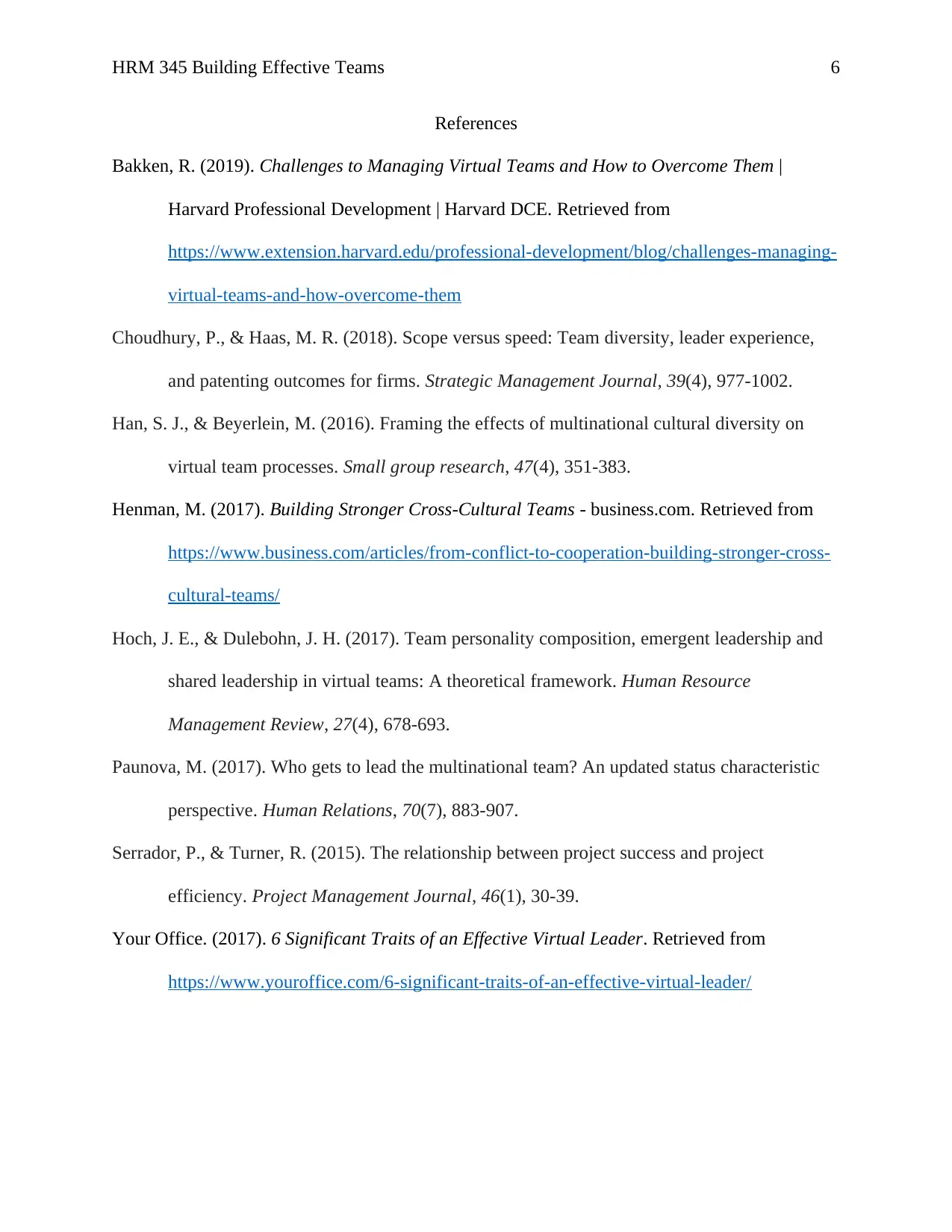
HRM 345 Building Effective Teams 6
References
Bakken, R. (2019). Challenges to Managing Virtual Teams and How to Overcome Them |
Harvard Professional Development | Harvard DCE. Retrieved from
https://www.extension.harvard.edu/professional-development/blog/challenges-managing-
virtual-teams-and-how-overcome-them
Choudhury, P., & Haas, M. R. (2018). Scope versus speed: Team diversity, leader experience,
and patenting outcomes for firms. Strategic Management Journal, 39(4), 977-1002.
Han, S. J., & Beyerlein, M. (2016). Framing the effects of multinational cultural diversity on
virtual team processes. Small group research, 47(4), 351-383.
Henman, M. (2017). Building Stronger Cross-Cultural Teams - business.com. Retrieved from
https://www.business.com/articles/from-conflict-to-cooperation-building-stronger-cross-
cultural-teams/
Hoch, J. E., & Dulebohn, J. H. (2017). Team personality composition, emergent leadership and
shared leadership in virtual teams: A theoretical framework. Human Resource
Management Review, 27(4), 678-693.
Paunova, M. (2017). Who gets to lead the multinational team? An updated status characteristic
perspective. Human Relations, 70(7), 883-907.
Serrador, P., & Turner, R. (2015). The relationship between project success and project
efficiency. Project Management Journal, 46(1), 30-39.
Your Office. (2017). 6 Significant Traits of an Effective Virtual Leader. Retrieved from
https://www.youroffice.com/6-significant-traits-of-an-effective-virtual-leader/
References
Bakken, R. (2019). Challenges to Managing Virtual Teams and How to Overcome Them |
Harvard Professional Development | Harvard DCE. Retrieved from
https://www.extension.harvard.edu/professional-development/blog/challenges-managing-
virtual-teams-and-how-overcome-them
Choudhury, P., & Haas, M. R. (2018). Scope versus speed: Team diversity, leader experience,
and patenting outcomes for firms. Strategic Management Journal, 39(4), 977-1002.
Han, S. J., & Beyerlein, M. (2016). Framing the effects of multinational cultural diversity on
virtual team processes. Small group research, 47(4), 351-383.
Henman, M. (2017). Building Stronger Cross-Cultural Teams - business.com. Retrieved from
https://www.business.com/articles/from-conflict-to-cooperation-building-stronger-cross-
cultural-teams/
Hoch, J. E., & Dulebohn, J. H. (2017). Team personality composition, emergent leadership and
shared leadership in virtual teams: A theoretical framework. Human Resource
Management Review, 27(4), 678-693.
Paunova, M. (2017). Who gets to lead the multinational team? An updated status characteristic
perspective. Human Relations, 70(7), 883-907.
Serrador, P., & Turner, R. (2015). The relationship between project success and project
efficiency. Project Management Journal, 46(1), 30-39.
Your Office. (2017). 6 Significant Traits of an Effective Virtual Leader. Retrieved from
https://www.youroffice.com/6-significant-traits-of-an-effective-virtual-leader/
⊘ This is a preview!⊘
Do you want full access?
Subscribe today to unlock all pages.

Trusted by 1+ million students worldwide
1 out of 6
Related Documents
Your All-in-One AI-Powered Toolkit for Academic Success.
+13062052269
info@desklib.com
Available 24*7 on WhatsApp / Email
![[object Object]](/_next/static/media/star-bottom.7253800d.svg)
Unlock your academic potential
Copyright © 2020–2025 A2Z Services. All Rights Reserved. Developed and managed by ZUCOL.





